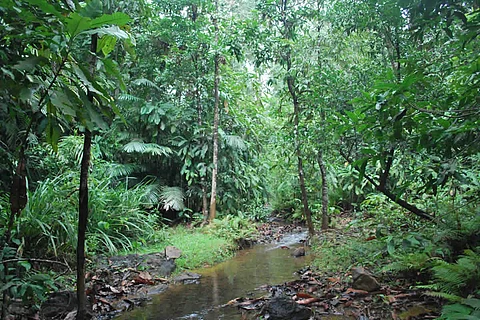

In June last year, the Sharavathi Wildlife Sanctuary, established in 1978, and the Aghanashini LTM Conservation Reserve, spread over 20,000 hectares of reserve forest in Shivamogga and Uttara Kannada districts, were merged to create the Sharavathi Valley LTM Sanctuary. The Myristica swamps of Uttara Kannada district, located within the forests of the Sharavathi river basin, are some of the rarest ecosystems in India. Conserving a patch of this sacred forest may be the key to the survival of a species on the brink.
While freshwater swamps are found in pockets across India – in the foothills of the western Himalayas, in the Terai belt, in Meghalaya, in the Andaman and Nicobar Islands, and in the Western Ghats – few swamps are known to host species in the Myristicaceae family. This is perhaps the oldest, most primitive flowering plant family in the world, with four genera and 15 species found in the Western Ghats. Yet these relic forests are few and often isolated by swaths of alternate land use, namely rice cultivation.
Cue the forests of the Sharavathi. The district of Uttara Kannada has 110 recorded freshwater swamps containing Myristicaceae members, i.e. Myristica fatua, M. arborea, or Gynmacranthera canarica. Other species thought to be extinct before their subsequent discovery in the swamps of the Western Ghats include Semecarpus kathalekanensis and Syzygium travancoricum, discovered in 2000 and 2014, respectively.
One of the best-known Myristica swamps in this forested region, Kathalekan, is revered by local communities and is the site of long-sustained religious practices. Such sites, designated as the home of indigenous deities, are known as sacred groves, or devara kaadu in Kannada. Swamps in the district are jointly managed by the state forest department and local communities, leading to a sense of ownership and responsibility for the maintenance of these relic forests. They are also protected for their ecosystem services – they allow for groundwater replenishment, prevent downstream flooding by retaining excess water, and purify the water supply downstream.
Myristica swamps | Pic by G Ravikanth
Protecting these sacred swamps has a bottom-up effect on other endangered residents of this landscape. The Western Ghats is home to a rare monkey, the lion-tailed macaque (LTM), locally known as the singalika. The LTM is listed on the International Union for Conservation of Nature (IUCN) as endangered, and the remaining populations are concentrated in the dense evergreen rainforests of the Western Ghats. They live their lives in the upper rainforest canopy, rarely descending to the ground. Given their primary diet of fruit, seeds and insects, they are restricted to rainforests, where resources are still plentiful. Habitat degradation is the main threat to their survival. A mere 3,500 of these macaques, fragmented into 49 separate sub-populations, are thought to exist in the Western Ghats.
Myristica swamps receiving protection from local communities provide a sanctuary for LTMs in these forests. While all swamps in Uttara Kannada district are not sacred, they serve as relic patches of forest with old-growth canopies for LTMs to reside. These primates feed on the fruit of the Myristica species, which fall within the nutmeg family. They discard the seeds when eating the flesh of the fruit, thus playing a key role as dispersers in this ecosystem. This behaviour allows for the reproduction of swampy species.
Apart from the LTM, swamps are home to 15 species of mammals, 59 species of birds, 22 species of reptiles, 29 species of amphibians, six species of fishes, 109 species of butterflies, and six species of damselflies, according to a study in 2006. Two genera of amphibians, Micrixalus and Nyctibatrachus, are endemic to these swamps and virtually unknown to researchers, making the conservation of these isolated patches a priority for conservation.
Micrixalus | Pic by Pradeep Hegde
Numerous Myristica swamps fall within the Sharavathi sanctuary. This adds weight to existing local protection on the valley and the swamps that exist here. Notification of the sanctuary also relieves the region of human extractive activities, including logging, collection of non-timber forest products, agriculture, hunting, fishing and poaching, among others.
Perhaps this is the key to the survival of a rare monkey and its equally rare habitat. LTMs and Myristica swamps both have specific climate and ecological requirements. Ecologically, they are changemakers in their larger landscape.
Found nowhere else on our planet, both swamp and macaque are throwbacks to a greener time in India’s past.
Priya Ranganathan is a wetland ecologist and geologist studying the inland wetlands of the Western Ghats.